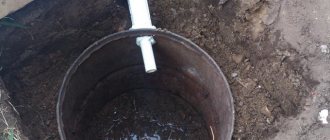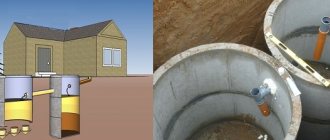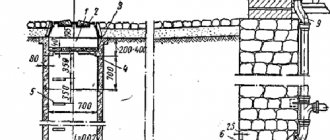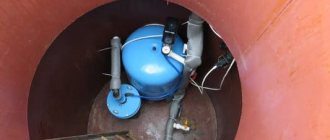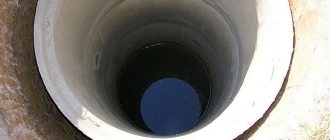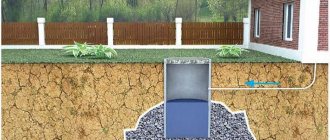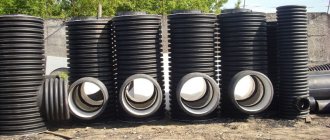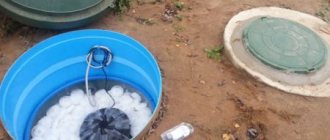Cesspool in a private house, diagram
Most owners of private houses believe that a drain tank is the most affordable and convenient way to collect wastewater in places remote from the centralized sewer system.
Cesspools according to the principle of cleaning can be divided into the following schemes:
- cesspool without a sealed bottom;
- pit with filtration;
- sealed storage pit cesspool;
- single-chamber septic tank.
Even the simplest two-chamber septic tank will be much more effective than the best storage tank
Traditional pit cesspool
This is the simplest and cheapest way to arrange a drain tank in a private home. The principle of its operation is very simple: household waste flows into a container and settles there. Biologically active sludge containing anaerobic bacteria forms at the bottom of the tank . These bacteria decompose organic matter. As a result, the water becomes clearer and seeps into the soil through holes in the walls and bottom.
A cesspool made of concrete rings without a bottom is a completely acceptable option for a home where the amount of wastewater does not exceed 1 m3 per day . But for a house with running water and modern household appliances, this design is not suitable: the volume of drained liquid will exceed the filtration capabilities of the sewer well and bacteria living in the sludge. Because of this, contamination of the aquifer and soil around the cesspool will occur. In addition, the use of modern detergents in washing machines requires a deeper cleaning compared to natural decomposition. For these purposes, a sewer system is required in a private house, a design whose installation depth provides additional filtration.
The construction of a cesspool made of concrete rings with filtration can significantly increase the volume of domestic wastewater. Thanks to the filter, a much larger volume of liquid will be absorbed into the soil . At the same time, the level of organic waste dissolved in it will not exceed acceptable standards and soil bacteria will be able to cope with them quite easily.
Sealed storage pit
A sealed drain option is advisable in cases where natural filtration is not possible . For example, if the soil on the site is unable to absorb a large volume of wastewater. A significant disadvantage of such a pit and its peculiarity is the need for regular pumping of the contents using a sewer truck.
Single chamber septic tank
Installing a septic tank is a more complex task, but it is quite doable on your own. Its principle of operation is as follows: in a sealed tank, step-by-step purification of household waste occurs . Immediately after leaving the sewer pipe, wastewater breaks down into fractions. Heavy particles settle to the bottom, and light particles float to the top. In this case, the wastewater is partially clarified and enters the drainage pipe, and then for soil treatment. A single-chamber septic tank cannot be considered an ideal option, but the degree of wastewater treatment in it is much higher than in conventional settling tanks.
It should be understood that a single-chamber septic tank and a drain (cesspool) are not the same thing
Advantages and disadvantages
One of the main advantages of a concrete cesspool is durability. The average service life of such a structure is 50 years. At the same time, regular cleaning and preventative repair work can extend this time. Other advantages of a concrete tank:
- The walls of such a pit are completely sealed (except for the joints of the rings). This allows you to ensure reliable protection of your site from contamination by waste;
- Reinforced concrete rings can be installed anywhere in the yard, regardless of the local groundwater level. For example, plastic tanks can float when exposed to underground currents. Because of this, the efficiency of the sewage system decreases;
- This type of drain is easy to care for. Sanitary cleaning can be performed with chemicals, biological activators or homemade sanitary mixtures. Mechanical cleaning of the bottom and walls from silt and solid waste is carried out in the most accessible and simple way - with a metal brush;
- Availability. You can buy concrete rings for a cesspool in almost every building materials store.
Cesspools made of reinforced concrete rings
But such a cesspool also has some disadvantages. The disadvantages of a waste tank made of reinforced concrete materials include:
- Difficult to install. It is quite difficult to organize the installation yourself without the use of lifting mechanisms. The weight of one concrete ring with an internal diameter of 70 cm is 46 kilograms. In this case, the installation must be done level;
- This design does not tolerate ground movements well. It is better not to install concrete pits on loams and heaving soils;
The process of installing concrete rings - It is difficult to maintain the required pit depth. Here, not only calculations of the required depth of the structure, but also the dimensions of the rings play an important role. Often you have to deepen the tank quite a lot. Because of this, problems may arise during further operation (difficulty in carrying out sewage cleaning, rapid silting of the bottom).
Calculation of the useful volume of a cesspool
A ring septic tank is perhaps the easiest way to install a sewer well for storing household waste. Its only drawback is the great physical effort required when installing heavy concrete rings.
The device begins with the calculation of its useful volume. When calculating it, the average daily water consumption per person is taken as a basis, which is 200 liters . This expense is multiplied by the number of family members and by 3 (the full cycle of wastewater treatment is three days). Therefore, for a family of 3-4 people you will need a cesspool with a volume of 2.5-3.0 m3.
Using a cesspool as a sewer
If autonomous sewerage is done in a country house or for a small house, then cesspools are simply an ideal option. But for a large cottage and a family of 5-6 people, it is better to choose a full-fledged septic tank with high wastewater processing capacity. It will cost more, but you won’t have to call the vacuum cleaners as often.
By the way, we recommend that you familiarize yourself with other aspects of construction, for example, types of roofing materials. A metal roof is an excellent universal option for any home.
Determining the required quantity of concrete products
To determine their number for the drainage pit, you must first calculate the volume of one element. To do this, use the formula: V = 3.14D2H/4 (D – internal diameter, H – height). By dividing the total volume of the cesspool by the volume of one ring, you can find out the required number of rings.
Technical parameters and dimensions of concrete rings for a septic tank must comply with GOST 8020-90 . Therefore, when calculating the volume, you can use the ready-made results presented in the table.
Volume of concrete rings:
| Designation | Inner diameter, mm | Outer diameter, mm | Height, mm | volume, m3 |
| KS-10-9 | 1000 | 1160 | 890 | 0,71 |
| KS-15-9 | 1500 | 1680 | 890 | 1,59 |
| KS-20-9 | 2000 | 2200 | 890 | 2,83 |
Typically, for a house inhabited by 3-4 people, 5 KS-10-9 rings are required . With their help, you can create a cesspool with a volume of 3.5 m3. If you need a larger volume do-it-yourself drain hole, then you need to take either a larger number of rings or choose rings with a larger internal diameter. Having calculated the volume of a cesspool made of concrete rings, you can make drawings for its installation yourself or find them in specialized literature.
The designation of the ring is deciphered as follows: KS - wall ring, the first number is the internal diameter of the ring, and the second is the height in decimeters
The use of concrete rings for sewerage in a private house is very economically beneficial. A cesspool made from concrete rings will always have a lower price than any other option using concrete. This is due to the fact that rings made industrially have a wall thickness of 7-10 cm , and when using concrete blocks or a “monolith” this parameter is 20-40 cm. Consequently, much less concrete is used for the rings, which makes them cheaper.
What to consider when creating a project
I tried several options and came to the conclusion that concrete rings are perhaps the best material. They are equally well suited for the construction of a multi-chamber septic tank in a modern cottage, and for a drainage pit in a small country house.
The fact is that new solid baked brick is expensive. And the quality of used brick structures is very mediocre. Plus you need to hire a mason.
Used solid brick cesspool.
For solid concrete septic tanks, you need to build formwork, and also spend money on the concrete itself and reinforcement, which is even more expensive. I don’t mention ready-made factory treatment facilities at all; the price there is exorbitant.
So it turns out that even if you order turnkey cesspools made of concrete rings from the relevant organizations, it will cost less than most of the above-mentioned options.
A serial factory septic tank is more expensive than a structure made of concrete rings.
What types of rings are there?
The ring itself is a solid, monolithic structure consisting of a welded metal reinforcing frame filled with high-strength concrete. They can be equipped with a shaped joining groove along the edge or have a smooth edge.
In addition to standard, classic products, rings with a bottom and so-called perforated rings are also produced. In our case, you can use all 3 types of structures.
But classic rings are significantly cheaper than glasses and perforated rings, so often most septic tanks and cesspools are built from standard models.
Concrete “glass” with a bottom.
Although here, not everything is so simple. According to GOST 8020-90, all such products are classified by diameter, wall thickness and height of the structure.
There are, of course, other characteristics such as the degree of reinforcement, grade of concrete, etc. But this information is taken into account when constructing important, for example, military facilities, but we simply do not need it.
Products with perforations on the walls.
There are also related products: monolithic round concrete slabs, with a diameter equal to the diameter of the ring, and the same slabs, but with a hatch.
The first option is used for quickly arranging the bottom of the well, and the second for installing the neck. By the way, it’s cheaper to buy a simple ring and a round bottom plate separately than to buy a whole glass.
Round stove with a neck.
Similar designs have been produced since the times when people came up with the idea of filling the reinforcement frame with concrete. Naturally, there are a lot of varieties. And so as not to get confused, I have compiled a small table. It contains 3 types of rings that are best suited for the construction of wells, septic tanks and cesspools.
| Parameters of the most popular concrete products according to GOST 8020-90 | ||||
| Marking | Internal diameter | Outer diameter | Wall height | Useful volume of the product |
| KS10-9 | 1000 mm | 1160 mm | 890 mm | 0.71 m³ |
| KS15-9 | 1500 mm | 1680 mm | 890 mm | 1.59 m³ |
| KS20-9 | 2000 mm | 2200 mm | 890 mm | 2.83 m³ |
In a nutshell about the secrets of marking: the abbreviation “KS” means “wall ring”. The first number indicates the internal diameter, the second the wall height. But in this case, the values are indicated in decimeters. Plus the height may have an error of +/- 10mm.
Products with a joining groove along the edge.
For us, one of the most important parameters is the volume of the product, I indicated it in the table. But I have met people who tried to fill such rings by hand at home. I very much doubt that this is profitable, although for those who decide to undertake such a feat of labor, there is a formula for calculating the volume of the ring.
V = πD²H/4
D – Inner diameter of the finished product;
H – Height of the ring wall;
π = 3.14.
How to calculate the dimensions of a septic tank or cesspool
We seem to have figured out the volume of one ring, now we just have to decide how many of these rings need to be dug in so that the drains don’t flow through the lid. There are average statistical data for this; in particular, they say that one adult uses 200 liters of water per day.
Deep concrete tank consisting of 5 elements.
That is, if you have a family of 4 people, then you need to count on 800 liters. But that's not all. It is not so important whether a regular cesspool is built from concrete rings or a septic tank with several chambers.
Remember, the first receiving chamber must accommodate 3 daily norms of waste, no less. Coming back to a family of 4, this would be 3200 liters or 3.2m³.
There is one more important point. The useful volume of the tank is calculated from the bottom to the sewer drain pipe. This is because if the drainage rises above the drain pipe, it will become clogged very quickly.
External waterproofing of a structure above the entry point of the sewer pipe.
From my own experience I will give you a little advice. When performing calculations, it is better to add a safety margin for one extra resident. This supply can come in handy when, for example, a large group of guests comes to you for the weekend, and everyone will definitely need to swim.
Where is the best place to lay a cesspool?
Of course, you are the boss in your yard, but domestic wastewater is a very harmful thing and a drainage pit made of concrete rings must be placed in accordance with established sanitary standards.
Otherwise there could be really big troubles:
- After all, if you install such a pit or septic tank in the middle of an orchard or vegetable garden, then your beautiful fruits growing within a 3-meter radius may smell completely different from what you expected. And worse, the content of various kinds of harmful chemicals in them will be off scale;
- It is highly undesirable to build such structures closer than 5m from buildings erected on a permanent foundation, including concrete fences. Otherwise, in a few years the drains will wash away the foundation and it will sag;
Option for the location of the drain on the site.
- The most stringent restrictions relate to maintaining a safe distance from the drain to the nearest drinking water intake, in other words, a well or borehole. Here you need to consider which direction the groundwater flows. So if a hole is dug downstream, then there should be at least 15 m from it to the well. If on the same parallel, then 30m. But the most dangerous thing is when the well is located downstream of the groundwater. In this case, the minimum is 50 – 70m;
- It is also not advisable to dig a drainage hole next to a neighbor’s fence. According to the rules, the distance must be at least 4 m;
- In addition, do not forget about the ease of operation of the sewage disposal machine. From the external (facing the street) fence to the pit there should be a minimum of 1 m, but a maximum of 4 m. If you place it too close, the car may accidentally move the rings when approaching. And if it’s far away, then the hoses may simply not be long enough.
Scheme of pumping wastewater using a sewage disposal machine.
And I would not advise you to neglect the above recommendations. After all, the Criminal Code of the Russian Federation contains Article No. 250, which provides for liability for harm to the environment, even criminal liability.
Choosing a location for a concrete cesspool made of rings
The basic rules for choosing the location of a cesspool are set out in sanitary norms and regulations (SNiP) . Regardless of what design a septic tank is chosen for in a private home, regulations require that it be located at a distance of at least five meters from the house. If there is a well with drinking water on the site, then the distance between it and the drainage pit should be at least 50 m. The maximum depth of the sewer well is chosen depending on the groundwater level. Such measures are necessary in order to prevent contamination of drinking water in the event of emergency destruction of the cesspool structure.
In addition, it is necessary to provide free passage for the sewer truck . The parameters of the access roads must ensure unhindered sewer pumping work. It should be noted that the construction of a sewer well with technical violations that pose a threat to the environment and human life falls under article of the Criminal Code of the Russian Federation No. 250. Therefore, compliance with the standards governing the construction of such facilities is mandatory.
Sanitary standards for cesspools
According to the text of the regulatory document, cesspools (see photo) must be built with a mandatory special filtration device, and they should not have a regular bottom under any circumstances, especially if during the day the amount of waste exceeds one cubic meter.
Such a distance from the house to the drainage pit is required so that the toxic gases emitted by the waste do not harm the local environment and people living in the area.
If there is a need to make the distance from the pit to the water supply closer, then you should contact the appropriate authorities (Sanitary and Epidemiological Supervision) and utility service companies (for example, water supply department, etc.).
Construction of a cesspool
Having decided on the volume and location of the cesspool, you can begin its construction. First, they dig a pit. This can be done manually or using a rented excavator. The bottom of the dug pit must be prepared depending on the selected type of cesspool. If a decision has been made on how to make a cesspool from concrete rings without a bottom, then you need to make a cushion of crushed stone . If a sealed design is chosen, then the bottom of the well must be concreted or a special ready-made ring with a bottom must be used.
The dimensions and geometry of the hole dug by an excavator will be much larger than required, which will entail the consumption of crushed stone for filling voids
After the concrete at the bottom of the pit has hardened, you can begin to lay the rings. Since concrete rings are quite heavy, a winch or crane is used to install them . The rings must be installed exactly end to end. After installing the rings in the drainage hole, the sewer pipe is removed from the house.
From above, the entire structure is covered with a concrete slab with an opening for maintenance . A cast iron hatch with polymer insulation is installed in the hole for tightness. Particular attention should be paid to waterproofing the sewer well. To do this, perform penetrating and coating (liquid glass and mastics) waterproofing of the rings. The joints between the rings are filled with cement mortar with the addition of liquid glass. The construction of the cesspool is completed by backfilling the pit with layer-by-layer compaction.
In the case when a cesspool is made in a private house, the design of which includes two chambers, the first container of concrete rings is waterproofed and the bottom is made, and when constructing the second, the rings are laid either on the ground or on a bed of gravel and sand without sealing the joints.
You can install a sewer system for a private house yourself or order a team of builders to install a cesspool made of concrete rings. The installation price in the latter case will depend on the design and size of the structure. For example, a drainage pit made of three KS-10-9 rings will cost approximately 25,000 rubles. The same pit, but complete with a two-ring drainage well, will cost 35,000 rubles.
Experts believe that cesspools made of concrete rings can last 100 years. Their arguments are based on the fact that concrete is a very durable building material and remarkably withstands the processes of rotting and fermentation that take place in wastewater.
How to construct a drainage pit from concrete rings with your own hands is shown in the video:
DIY drainage hole
To make a drainage hole with your own hands, several steps are required. The first of which is the selection and preparation of the site for the pit. A location closer than 5 meters from the foundation over time can cause concrete deformation and shrinkage of the house. The distance to the neighboring area should not be less than 3 meters. The distance from water intake wells, depending on the type of soil, can be 20-50 meters.
Return to contents
Volume calculation
The next stage is planning the construction. Its volume is planned taking into account the number of people living and the amount of waste per day. According to sanitary standards, the volume held by a cesspool must exceed the volume of water used per day by all residents by three times. The water consumption rate per person is 200 l/day. Accordingly, for a family of 4 people the calculation is as follows:
- 4 × 200 × 3 = 2400 (l)t or 2.4 (m3).
Thus, the minimum volume of drainage in a concrete pit will be 2.4 m3.
Return to contents
Digging a pit
The pit is dug with your own hands or using special equipment. Its width must be made depending on the diameter of the built-in concrete rings. The depth is 3 m, in this case the sewer truck will be able to pump out all the sewage. In addition, the close proximity of groundwater does not allow digging a deeper well. In this case, to increase the volume of drainage, you will have to use large-diameter concrete rings. For the convenience of further work, the diameter of the pit should be 60-100 cm wider than the diameter of the rings.
Return to contents
Preparation of the solution
To install concrete pits with a bottom, you can use either a lower ring with a previously poured bottom on the surface, or cast it directly in the pit. To do this, a concrete solution is poured onto a compacted bed of sand and crushed stone. The proportions of such a solution are 4:6:1 - sand, crushed stone and cement, respectively. It will take 3-4 days for the solution to “set”.
Return to contents
Pipe laying
If we are talking about structures with an overflow, then the construction of a second settling tank becomes necessary, but unlike the first, it is designed without a bottom. Such tanks are connected to each other by a pipe at a distance of 50-80 cm from the surface. The slope is towards the drainage tank. Next, sewer pipes with a diameter of 15 cm are connected to the tank. A prerequisite is that the slope be close to 15 °.
Return to contents
Cesspool walls
Holes for pipes in a concrete ring can be made with a hammer drill.
After the base has completely hardened, they begin to install the concrete rings directly. Using a crane or winch, they are installed one at a time on top of each other. After connecting the sewer pipes, the joints and connections are sealed with a concrete solution and waterproofing is carried out, most often with bitumen.
After connecting the pipes to the tank, a control check is carried out. If the outflow is free, begin to cover the pits. To do this, a cover with a hole for the hatch is placed on the last of the rings for the drainage pit. Cover with a wooden lid with insulation. After which the pit is filled with sand and crushed stone, and then a concrete covering is made - a finished concrete slab or filled with mortar, leaving a hole for a hatch through which waste will be pumped out.
Return to contents
Ventilation installation
The ventilation riser must be at least 60 cm above the ground level, and its diameter should be about 10 cm. The pipe installation should be at a level of 30 cm from the maximum filling mark. The ventilation hole should be covered with a loose fitting lid. We concrete the site after completion of all work, including installation of ventilation.
Return to contents
So that the cesspool serves as a septic tank
To do this, you need to make another tank according to the same principle, which should be deeper than the first hole. Thus, the first pit will serve as a filter, and the second will be the cesspool itself. The second pit will not have a concrete bottom, and at the bottom there will simply be a layer of sand and crushed stone as drainage.
After you have laid the concrete rings, you need to check the cesspool for functionality. If everything works properly, then you can fill the hole with earth and begin work on improving the surrounding area.
After this, it is also necessary to take care of the cover, since unpleasant odors of pleasant origin will penetrate from the cesspool. The cover should have round holes so that sewage can then be pumped out through them.
Pros and cons of a filter cesspool
Structurally, a filter cesspool differs from a sealed structure in the ability to drain wastewater through the bottom filter and walls. This functionality has its positive and negative sides.
The advantages of a sewer well without a bottom include the following:
- Low cost of construction due to the absence of the need for formwork and concreting during its construction.
- Compactness. The volume of the filter tank usually does not exceed 2 m3, so an autonomous sewage system created on its basis takes up little space on the site.
- Ability to purify liquid waste naturally. This is the most significant advantage of this design. Due to the fact that part of the wastewater is filtered through the walls and bottom of the tank and goes deep into the soil, the services of vacuum cleaners are required less frequently. The economic effect is obvious here.
Disadvantages of a cesspool without a bottom:
- Remote location. According to SNiP, filter drainage pits are required to be installed much further from sources of water or housing than similar closed structures. The reason for this is the risk of soil contamination if sewage penetrates into it. The usual distance from the site for such wells is increased to 20 m.
- Environmental hazard. If untreated runoff enters a soil aquifer, it can quickly spread for many kilometers, poisoning the soil and thereby reducing its fertility. Therefore, in this case there is no need to even talk about a high yield from the garden or garden.
- Limitation on well volume. For a large family, a small filter cesspool will not be enough. It makes no sense to increase its volume, since this will absolutely not affect the hygroscopicity of the bottom of the tank. After all, filtration is a long-term process that can end with stagnation of wastewater when the permitted size of such a cesspool increases.
